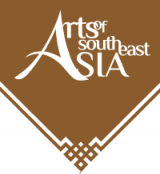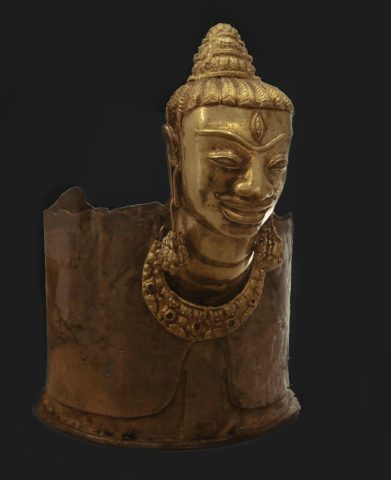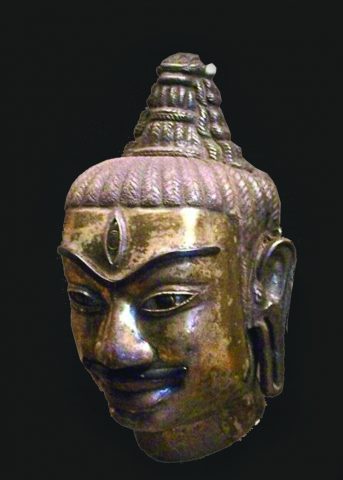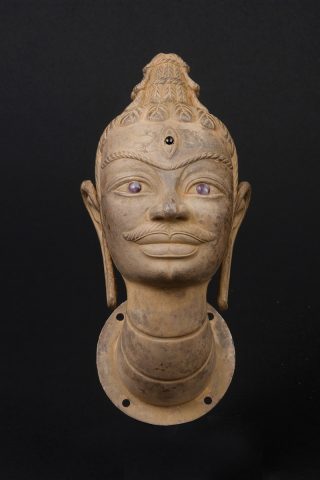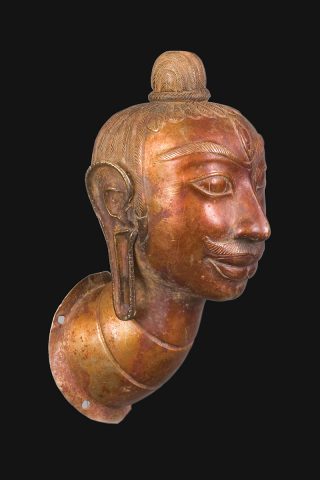Volume 1, Issue 4, September–October 2020.
The Gold Kosa of Phu Long
by Prof. Dr. Ngo Van Doanh
A representative of the Quan Nam Provincial Museum announced, at the XXXIII Vietnam Archaeological Conference, that the gold head of a Shiva statue had been found while searching for scrap metal in Phu Long (Dac Loc, Quang Nam). The statue is 24 cm high and weighs 0.58 kg, with a conical head disk, which is twisted twice at the top. The cone is divided into four segments which were made separately, and then fixed to the top of the head by bending the rim back into the head. There is a third eye in the centre of the forehead that is aligned vertically, while the two main eyes are set slightly oblique on either side of the tip of the nose. The pupils and irises are visible on all three eyes. Both eyebrows are thin and intersect in the middle of the forehead. The nose is straight and high, the alae of the nose are thin, there is a thick moustache that curves slightly upwards. The mouth is smiling, the lips are thin, his ears are elongated, with artificially shaped long earlobes. The head inclines forward, with three grooves on the long neck that curve backward. The end of the neck tapers outwards and has a rim. There are four square holes (7×4 mm) on the neckline. The head itself is hollow. The convex and concave portions on the inner surface of the head are clearly visible that correspond to the convex and concave portions of the outer surface.
Based on technical traces, the gold Shiva head was made by hammering and soldering. According to experts from the Quan nam Provincial Museum, the Shiva head at Phu Long can be classified as belonging to the Khuong My style and dates back to the tenth century. The gold head of Shiva underwent another examination two years after the archaeological conference, during which another important finding was made. Its basic statistics are as follows: the height of the hollow gold head is 24 cm, the width of the centre of the head (from ear edge to ear edge) is 12 cm. The face of the statue is oval in shape, the chin is rounded, the moustache is quite large and the two ends curve upwards, the nose is straight, the eyebrows form a convex line and run across from one temple to the other, curving at the beginning of the top of the nose forming a bow shape. The third eye has neither pupil nor iris, the eye is arranged vertically and in the middle of the forehead. He has large, long ears, with ear lobes that might have been designed to wear jewellery. The hair is seen in the form of braided strands and stands upwards in the shape of a high knot of hair (jata). This slightly inclined hair ‘bun’ was encircled twice with braided strands to keep it in place.
The hair knot section was made separately and subsequently fitted to the top of the head, and it might also have been attached to a vertical column (Linga). The structure of the neck is really quite special: it is long and has three curving wrinkles that gradually broaden as they extend to the rear to form a vertical cross-section parallel to the face to be attached to the vertical column (Linga), there are four square holes at the round rim at the end of the neck. The outer surface of the statue head is covered with a reddish-brown patina.
A thorough examination of the head revealed that the Phu Long Shiva head Kosa was made from a precious metal, gold, resembling those seen on the Cham reliefs. However, based on the sculptural stylistic features (the moustache is large enough and the two ends curve up – wards, the eyebrows form a convex line that runs from one temple to the other, and curves at the beginning of the top of the nose, forming a bow, the hair is formed of braided strands, and stands upwards in the shape of a bun that is twisted twice horizontally…). It is possible to determine that the golden Phu Long Kosa is a work of art belonging to the Dong Duong style, dating back to the late ninth century or early tenth century. In addition, it is also important to note that the Phu Long head is based on some sculptural elements (straight nose, large round chin, large and long ears, braided locks of hair, three-section neck, convex eyebrows, pupils and irises…) that are very close to those of the Laksmindra-Lokesvara bronze statue discovered in Dong Duong in 1978, which was declared a national treasure by the Vietnamese state in 2012 and is currently housed in the Champa Sculpture Museum in Da Nang. 1
Based on all the above, it can be concluded that until the end of the twentieth century the gold Shiva head (kosa) at Phu Long was the second precious metal Kosa from the Cham culture to be discovered in Vietnam. The first Shiva gold head was found at Huong Dinh (Phan Thiet) in the early twentieth century. According to J. Boisselier’s studies, the style of the Shiva statue head from Huong Dinh is reminiscent of the late period of My Son E.1 (first half of the seventh to ninth centuries), especially because of the eyebrows, moustache and long beard (see the Shiva Stone Statue at My Son A.1 Temple, Da Nang Museum), but there are no curved strands of hair on the temples, which are unique to the Dong Duong style.
J. Boisselier also stated that the hair knot or ‘jata’ on the gold Shiva head from Huong Dinh is very small and does not resemble any of the known styles. J. Boisselier also observed a thin, moon-shaped decoration on the jata on the Huong Dinh Shiva’s head that, unusually, leaned slightly to the left. J. Boisselier concluded from his analyses that the gold head at Hung Dinh had held mobile jewellery: holes drilled in the lower part of the pinna, a slanted neck—that is, presumably the gold head had been decorated with earrings and a necklace. Shiva heads (Kosa) made of gold are rare and highly-prized treasures, outstanding works of the Cham goldsmith’s art of which very few have survived the storms of history. Thus, outside of Vietnam, they can be viewed in a few museums around the world (Guimet Museum, Metropolitan, Singapore History Museum, Berlin Museum of East Asian Art) as well as some private collections (Dr. István Zelnik Southeast Asian Gold Museum).
References
1 Kosa in religion and art of Champa, Vietnam Social Sciences mN3.2001, pp.39-44
2 J. Boisselier, La statuaire du Champa, Recherches sur les Cultes et l’Iconographie, EFEO, Paris, 1963, p.413.
3 Dr. Tran Duc Anh Son, Vietnamese Antique Objects in the world: treasures of the Cham dynasties, CAND, 21.07.2011.
4 Jean-Francois Hubert, Art of Champa, Paris, 2005.
